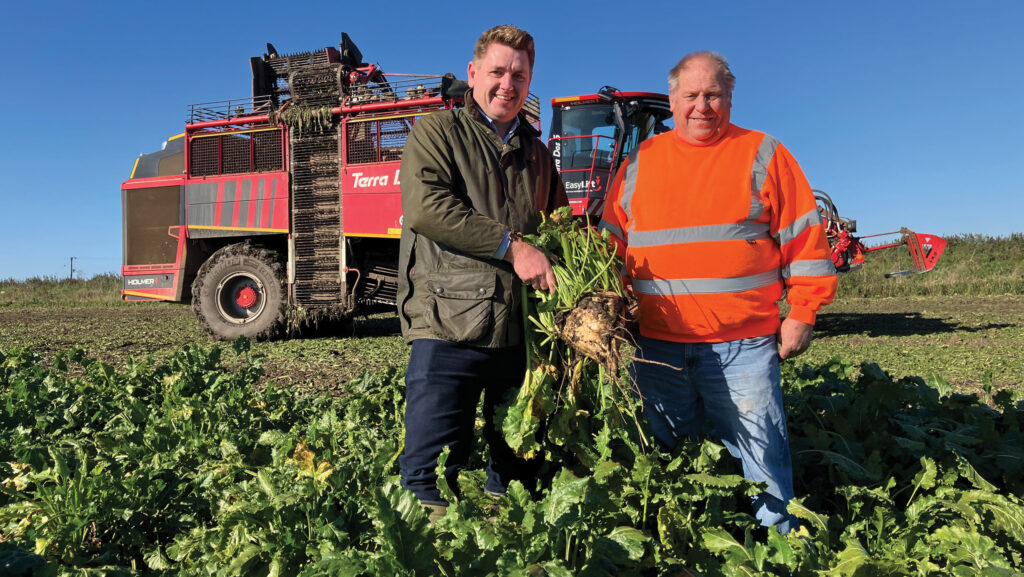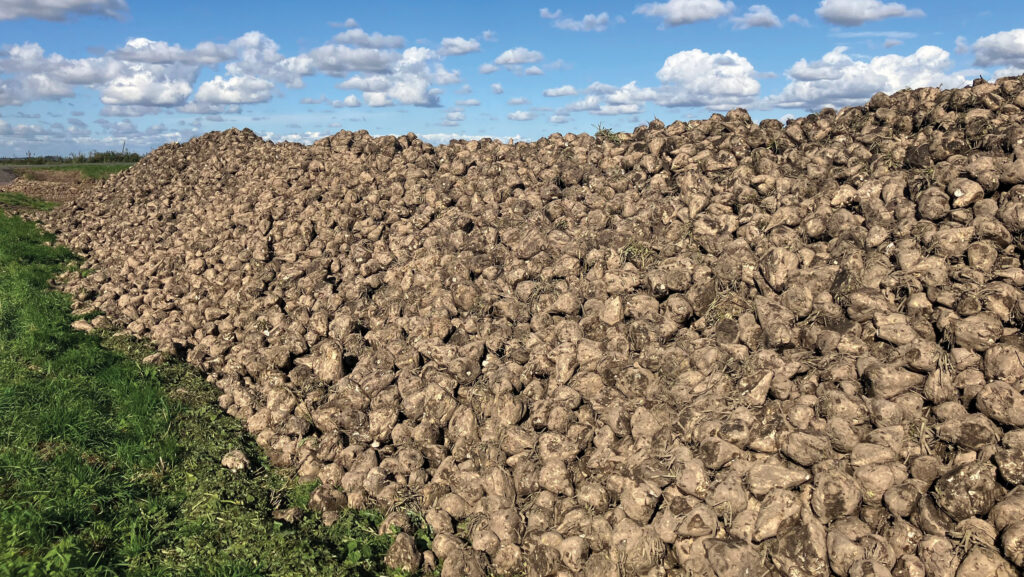Video: Sugar beet harvest 2024 starts with highs of 100t/ha
 Nick Morris (left) and Richard Ivatt © MAG/Emma Gillbard
Nick Morris (left) and Richard Ivatt © MAG/Emma Gillbard The 2024 sugar beet harvest is off to a promising start, as some early-lifted crops already hit over the 100t/ha mark and sugar levels hold firm.
Lincolnshire beet grower and harvesting contractor Richard Ivatt is set to harvest a staggering 1,500ha area of the crop this campaign, and despite the wet weather, is making good progress.
See also: Wheat variety winners and losers in challenging 2023/24 season
“Thankfully, it’s been far from the disaster we were expecting. We’ve harvested about 250ha so far and we’re getting into some really good crops now, doing 80-90t/ha,” says Richard.
“We have already lifted beet yielding more than 100t/ha in the Spalding area.
“This was on some really nice land, but we lifted this three weeks ago, which is unusually early for the season,” says Richard.
Watch the video below to see the harvest in action.
Sugar high
Sugar contents are also performing well despite the relatively dull growing season, with low sunlight and plentiful cloud cover.
Nick Morris, head of agriculture supply chain at British Sugar, explains that sugar levels were slightly low for the first week of the campaign, but have since climbed and are now substantially ahead of last year.
“We are currently averaging around 17% sugar for the beet delivered to our factories so far.
“The long-term average for the whole campaign is around 17.5% sugar, so we wouldn’t usually expect to see the full content this early on in the season, especially in a year of low light intensity,” says Nick.
Sugar content of beet typically increases throughout the campaign from September until mid-November, before plateauing, so it is looking to be a promising start for beet growers.
“This is a real testament to the crop and it’s growers,” continues Nick.
Adding to this good spirit is British Sugar’s agreed £40/t contract price for harvest 2024/25, which represented a 48% price increase on harvest 2022/23.
Richard is consequently selling 100% of his 160ha sugar beet crop he grows on the home farm near Bourne at this price.
Next year’s British Sugar’s agreed price for the 2025/26 beet crop is dropping by £7/t to £33/t as a result of a dip in the world sugar markets.
Nick notes: “Just like any global commodity market, it peaks and troughs. The global sugar price has been high for the last couple of years, but has dipped.”
Neonic derogation uncertainty
Another concern for many of the UK’s 2,300 sugar beet growers is whether the new Labour government will continue the neonicotinoid emergency authorisation for the control of aphid-spread virus yellows for the 2025 harvested crop.
Previously, use of the insecticide seed dressing Cruiser SB (thiamethoxam) was permitted in England if a threshold of virus incidence of 65% or more was predicted.
This year’s threshold was set at the highest level yet, which saw Richard treat all but two fields with the seed dressing on the home farm.
“We drilled two fields early on, so we did not get the derogation. We did apply one insecticide spray on this area.
“There was noticeably more disease in the non-cruiser SB treated crops, but nothing like 2020, which was a disaster for virus yellows,” says Richard.
British Sugar has made the request to the government for the emergency authorisation, but are still waiting for a response.
Nick notes this year has seen exceptionally low levels of virus yellow. “There is some primary infection in crops, but thankfully no secondary infection.”
Importance of sugar beet
Sugar beet is an important part of the rotation for Richard and his family, who have grown the crop for 60 years.
Firstly, it acts as an excellent break crop, reducing blackgrass pressure on heavier land by acting as an effective cultural control in the spring.
Secondly, it also enables late-winter lifting opportunities on lighter ground, which would otherwise be too marginable for winter wheat.
“We can let the beet crops gain more yield potential over winter and provide the perfect entry for a spring crop,” he says.
Richard opts for a seed rate of 110,000 seeds/ha, aiming for the target population of 100,000 plants/ha.
He typically uses a Discordon cultivator in the autumn, although some land is ploughed. This is followed-by a Vaderstad Tempo drill on predominantly 50cm row spacing.
He has even tried some direct drilling of sugar beet and is hoping to do more this season, weather dependent.
“Most of our sugar beet crops follow winter barley, but on the heavy land, this will will follow winter wheat,” he adds.
Richard works alongside son-in-law Mark Grimmett, who together, do the farm’s own agronomy and contract drill 550ha of sugar beet, which runs from March until May.
This season the drilling campaign began before the pair had even finished harvest of the previous crop.

© MAG/Emma Gillbard
Cutting N rates
A top focus for Richard is reducing nitrogen rates, which has seen him successfully cut 20kg N/ha through the use of precision fertiliser placement at drilling.
Previously, a total of 120kg N/ha was applied, but thanks to seed placement technology, Richard now accurately places fertiliser granules in the seed-bed 25mm beneath and 25mm to the right of the seed at drilling. He then follows up with a second application three weeks later.
“We are definitely learning to grow the crop with less nitrogen, without seeing any yield detriment,” he says.
What’s more, because amino nitrogen and sugar levels are linked, this could be a contributing factor to the greater sugar levels this season.
“As amino nitrogen content rises above a threshold, sugar content begins to dilute, but there is obviously a fine balance to getting this right,” says Richard.
A biostimulant trial is also underway this season, looking at reducing heat and drought stress in sugar beet on some of the farm’s light land.
British Sugar harvest progress and new app launched
British sugar has currently processed about 10% of it’s expected volume, with all four UK factories now open: Bury St Edmunds, Wissington, Newark and Cantley.
A total of 102,000ha of sugar beet is in the ground this year – up on last year’s 99,000ha, and 90,000ha in 2022.
British Sugar has launched two new apps for this year’s harvest campaign known as “Lifted: for harvesters and “Delivered” for hauliers, which aim to connect stakeholders throughout the sugar beet supply chain.
British Sugar’s Nick Morris says: “It hopes to connect farmers, contractors and hauliers to create more visible progress during the sugar beet harvest campaign.”
Rather than making multiple calls between each stakeholder, users can simply log in to the app and identify the status of fields.
“The app shows where fields are for harvesters and hauliers, and whether crops have been harvested or delivered to the factory.
“This enables a more translucent and streamlined approach to the campaign, helping achieve a shorter window between harvesting and delivery.”

